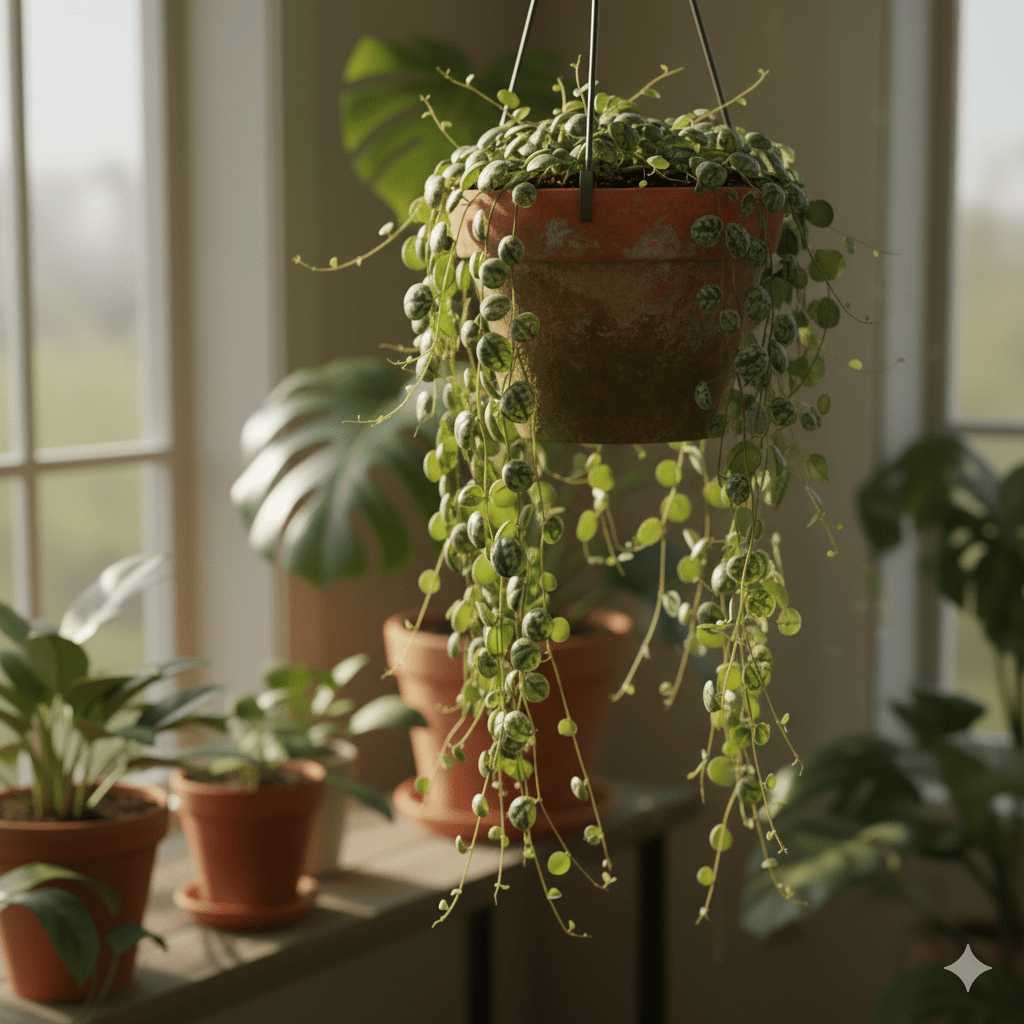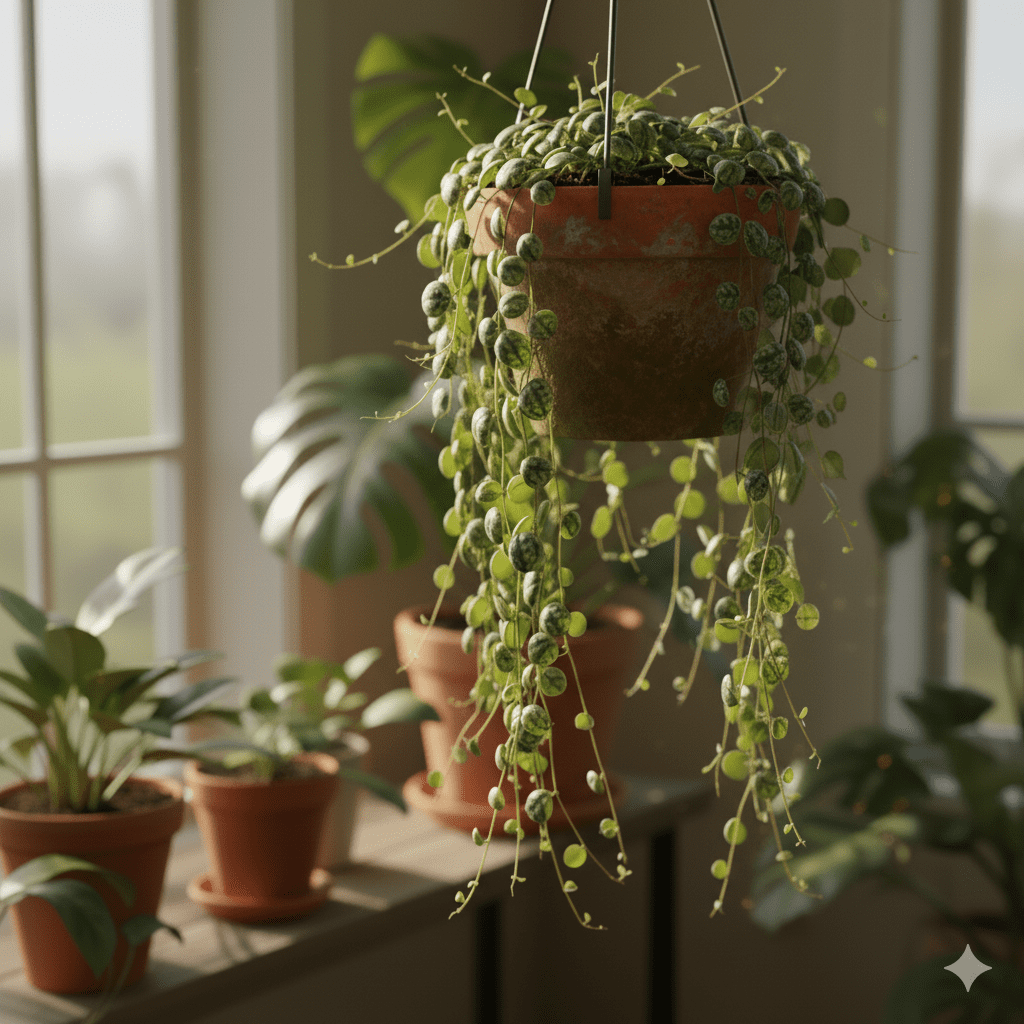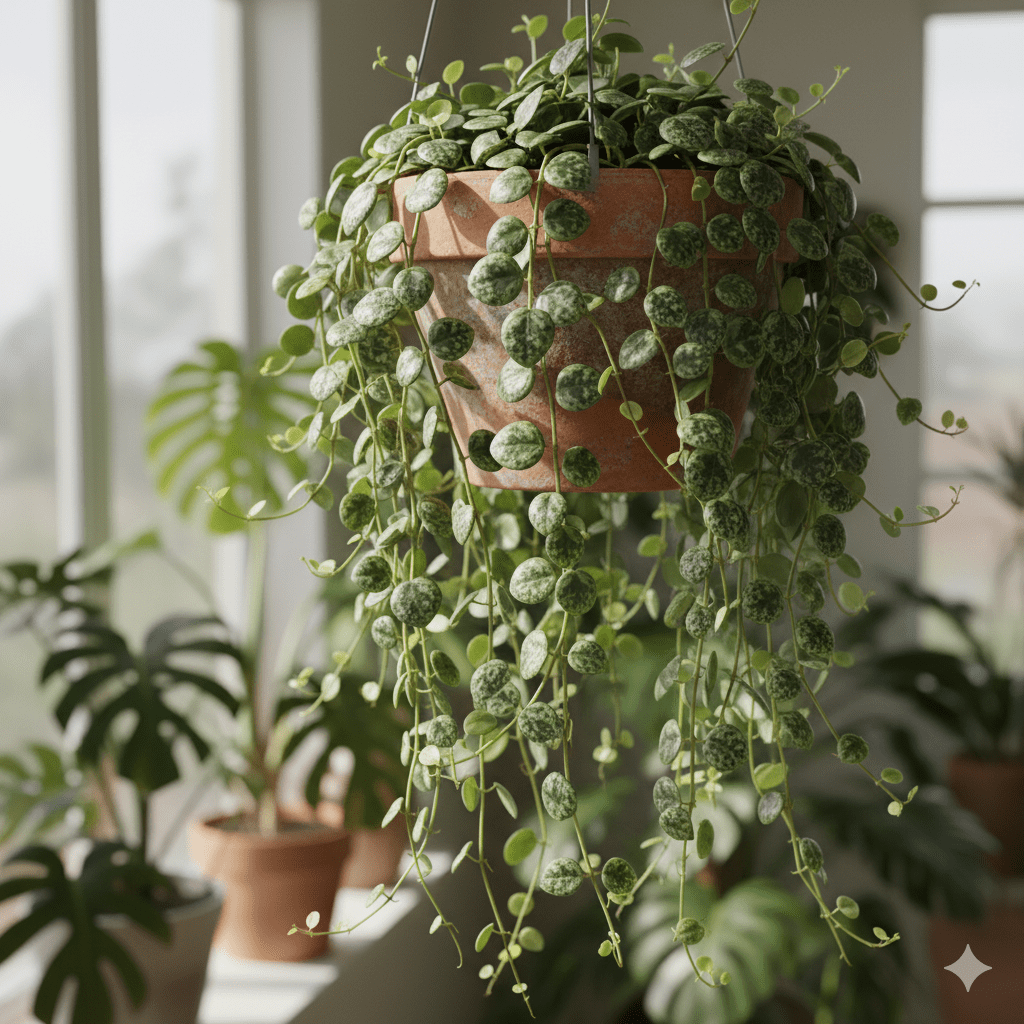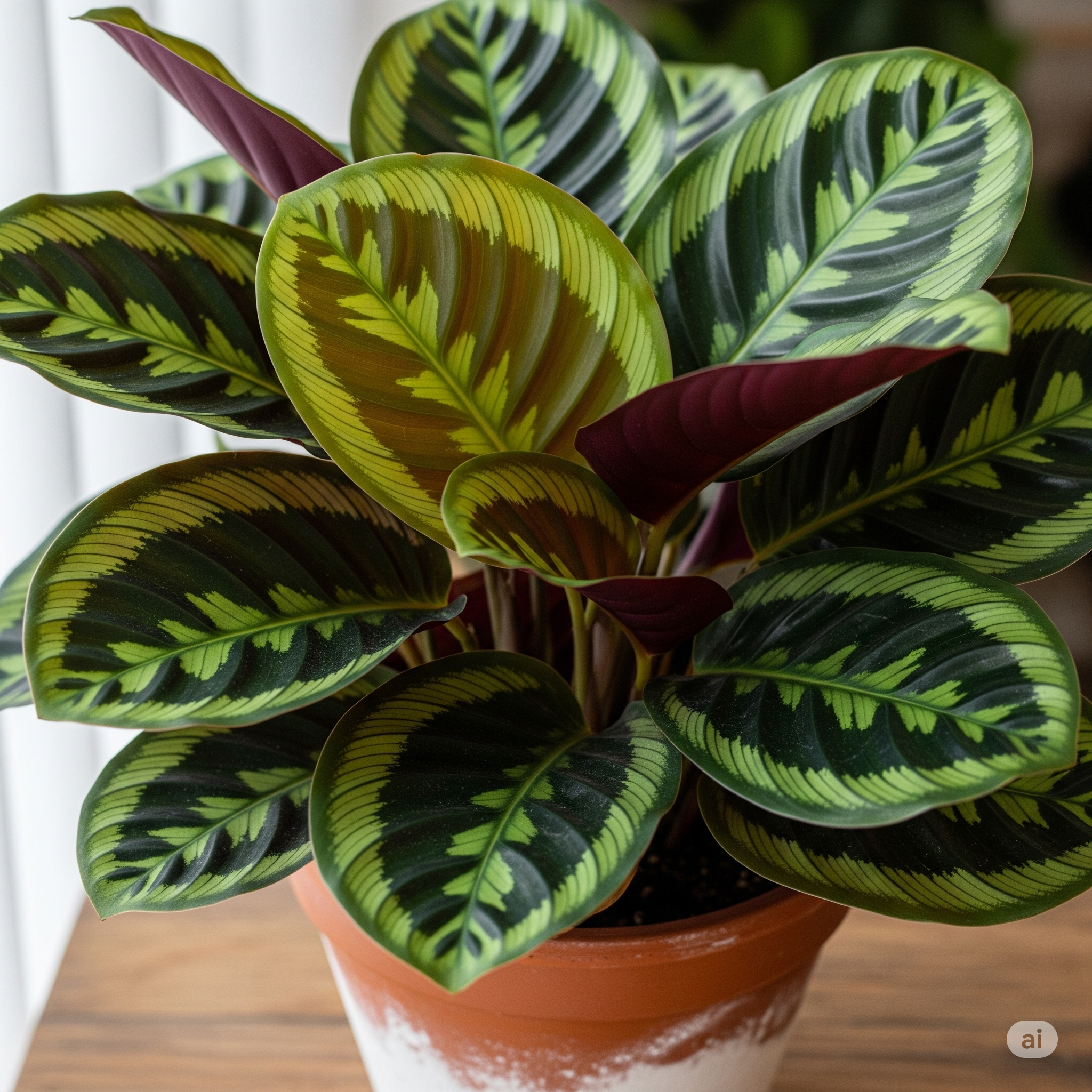Some links on this Website are affiliate links, meaning we may earn a commission if you make a purchase, at no additional cost to you. Please read our full Affiliate Disclosure for more details.
If you’ve ever scrolled through plant lover feeds on Instagram or Pinterest, you’ve probably seen the adorable String of Turtles plant. With its tiny, round leaves that resemble turtle shells, it’s no surprise that this charming succulent-like plant has become a favorite among indoor gardeners.

Known scientifically as Peperomia prostrata, this plant is native to the rainforests of Brazil, where it grows in warm, humid conditions under the shade of taller plants.
Learning how to care for a String of Turtles plant is easy once you understand its natural environment. It prefers indirect sunlight, moderate watering, and well-draining soil — making it a perfect choice for plant parents who want something unique yet manageable. Let’s look at everything you need to know about keeping your String of Turtles happy, healthy, and thriving.
Getting to Know Your String of Turtles (Peperomia Prostrata)
Before diving into care routines, it helps to understand what makes this plant special. The String of Turtles is a small, trailing plant that belongs to the Peperomia family. Unlike many succulents, it’s not entirely drought-tolerant but prefers a balance between moisture and dryness. Its delicate vines grow slowly, cascading beautifully from hanging pots or small containers, making it an excellent choice for windowsills, desks, or terrariums.
Because it’s a compact and slow-growing plant, you won’t need to prune it often or repot it frequently. With the right conditions, it can live for years and continue to produce new vines that create a lush, cascading effect.
String of Turtles Light Requirements

Light plays a major role in keeping your String of Turtles looking its best. This plant thrives in bright, indirect light, similar to what it would receive in its natural rainforest habitat beneath a canopy. An east- or north-facing window is ideal, as it provides gentle morning sunlight without the harsh midday rays that can burn its leaves.
Too much direct sunlight can cause the vibrant green and silver patterns on the leaves to fade or even scorch. On the other hand, too little light can lead to stretched, leggy growth as the plant reaches toward the light source. If your home doesn’t get much natural sunlight, you can supplement it with a grow light to ensure your plant receives enough illumination.
Remember: consistent, filtered light is the key to maintaining the plant’s beautiful markings and compact growth.
String of Turtles Watering Tips
Watering is one of the most important aspects of String of Turtles care, and getting it right can make all the difference. Unlike desert succulents, Peperomia prostrata prefers slightly moist conditions but hates sitting in soggy soil. The general rule is to allow the top 1–2 inches of soil to dry out before watering again.
During the growing season (spring and summer), you’ll likely water once every 7–10 days. In the cooler months, when the plant’s growth slows down, you can reduce watering to once every 2–3 weeks. Always use a pot with drainage holes to prevent water from pooling at the bottom, which can cause root rot.
If you notice the leaves turning soft and mushy, that’s a sign of overwatering. Conversely, wrinkled or shriveled leaves indicate the plant needs more water. Always check the soil moisture before reaching for your watering can.
How Many Lumens do Plants Need?
The Best Soil Mix for Peperomia Prostrata Care
A well-draining soil mix is essential for Peperomia prostrata care. The plant’s delicate roots need air circulation and don’t tolerate compacted, waterlogged soil. The ideal mix should be light, airy, and fast-draining.
A great homemade blend consists of:
- 50% succulent or cactus mix
- 25% perlite or pumice for aeration
- 25% orchid bark or coco coir to retain just enough moisture
This mix mimics the plant’s natural growing environment and prevents root rot. Repotting should only be done every 2–3 years or when the plant becomes root-bound. When repotting, handle the fragile vines and roots gently to avoid breakage.
Temperature and Humidity Requirements

The String of Turtles thrives in warm, humid environments — much like its tropical origins. The ideal temperature range is between 65°F and 80°F (18°C–27°C). It’s important to keep the plant away from cold drafts, air conditioners, or heaters, as sudden temperature changes can stress it out.
Humidity plays a big role in keeping the foliage lush and healthy. Aim for 50–70% humidity, especially if you live in a dry climate. You can increase humidity by using a humidifier, grouping your plants together, or placing your pot on a pebble tray filled with water. If you notice the leaves drying out or the edges curling, that’s a sign the air is too dry.
Fertilizing Your String of Turtles
Feeding your plant helps it grow stronger and maintain vibrant foliage. During the growing season, feed your String of Turtles every 4–6 weeks with a balanced, diluted liquid fertilizer. Make sure to use a half-strength solution, as over-fertilizing can damage the plant’s roots.
In fall and winter, stop fertilizing altogether since the plant naturally enters a dormant phase. Too much fertilizer during this time can lead to salt build-up in the soil and harm the roots.
7 Easy Tips For Growing Plants Indoors
How to Propagate a String of Turtles
Propagating your String of Turtles is simple and rewarding. The best time to do this is during the spring or early summer when the plant is actively growing.
Here’s how to do it:
- Cut a healthy vine just below a leaf node using sterilized scissors.
- Place the cutting on top of moist soil, ensuring that the nodes touch the surface.
- Keep the soil slightly damp and the plant in bright, indirect light.
- Within a few weeks, roots will begin to form, and you’ll notice new growth.
You can also root the cuttings in water before transferring them to soil. Propagation is a great way to create new plants for yourself or share them with fellow plant lovers.
Can I Save A Plant From Root Rot?
Common Problems and How to Fix Them
Even with the best care, issues can occasionally arise. Here are some common problems and their solutions:
- Yellow leaves: Usually caused by overwatering. Allow the soil to dry out before watering again.
- Fading leaf patterns: The plant is getting too much direct sunlight. Move it to a spot with filtered light.
- Leggy growth: Not enough light. Place it in brighter conditions.
- Shriveled leaves: Indicates underwatering or low humidity. Water more frequently and increase humidity levels.
Regularly inspecting your plant will help you catch these issues early before they cause lasting damage.
Frequently Asked Questions (FAQ)
1. Is a String of Turtles easy to care for?
Yes! The String of Turtles plant is relatively easy to care for as long as you provide moderate watering, indirect light, and good humidity.
2. How often should I water my String of Turtles?
Typically once every 7–10 days, but always check that the top layer of soil is dry before watering again.
3. Can the String of Turtles tolerate low light?
It can survive in low light, but it won’t thrive. The leaves may lose their pattern or become leggy. Bright, indirect light is best.
4. Why are my String of Turtles leaves falling off?
This often happens due to overwatering or sudden temperature fluctuations. Adjust your watering schedule and keep the plant in a stable environment.
5. Do String of Turtles like to be misted?
Light misting is fine, especially in dry rooms, but avoid overdoing it. Too much moisture on the leaves can cause fungal problems.


